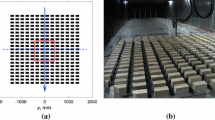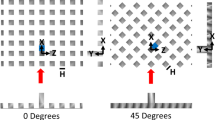Abstract
Water-tunnel measurements of velocity, turbulence and scalar concentration for three model urban canopies with aspect ratios A r of building height-to-width of 0.25, 1 and 3 are presented. The measurements for the canopies with A r = 1 and 3 are new, while the measurements for A r = 0.25 were previously published. A passive scalar was continuously released from a near-ground point source, and the concentration was measured at several distances from the source and at different heights above the ground. Plume spreads, concentration and distance from the source were non-dimensionalized using length, time and velocity scales reflecting the geometry of the buildings. The scaling collapses the data for all aspect ratios and is valid when the vertical extent of the plume is smaller than the canopy height. The observed plume spreads are compared with analytical relations, which predict linear growth in both transverse and vertical directions. The observed mean concentration is compared with a Gaussian dispersion model that predicts a −2 power-law decay with distance from the source.
Similar content being viewed by others
References
Biltoft CA (2001) Customer report for Mock Urban Setting Test. Tech. Rep. WDTC-FR-01-121, U.S. Army Dugway Proving Ground, Dugway, Utah
Castro IP, Robins AG (1977) The flow around a surface-mounted cube in uniform and turbulent streams. J Fluid Mech 79: 307–335
Castro IP, Cheng H, Reynolds R (2006) Turbulence over urban-type roughness: deductions from wind-tunnel measurements. Boundary-Layer Meteorol 118(1): 109–131
Cheah SC, Cleaver JW, Millward A (1983) Water channel simulation of the atmospheric boundary layer. Atmos Environ 17(8): 1439–1448
Cheng H, Castro IP (2002) Near wall flow over urban-like roughness. Boundary-Layer Meteorol 104(2): 229–259
Chin HNS, Leach MJ, Sugiyama GA, Leone JM, Walker H, Nasstrom JS, Brown MJ (2005) Evaluation of an urban canopy parameterization in a mesoscale model using VTMX and URBAN 2000 data. Mon Weather Rev 133(7): 2043–2068
Coceal O, Thomas T, Castro IP, Belcher S (2006) Mean flow and turbulence statistics over groups of urban-like cubical obstacles. Boundary-Layer Meteorol 121: 491–519
Collier CG (2006) The impact of urban areas on weather. Q J R Meteorol Soc 132(614): 1–25
Counihan J (1969) An improved method of simulating an atmospheric boundary layer in a wind tunnel. Atmos Environ 3(2): 197–200
Delle Monache L, Weil J, Simpson M, Leach MJ (2009) A new urban boundary layer and dispersion parameterization for an emergency response modeling system: Tests with the Joint Urban 2003 data set. Atmos Environ 43: 5807–5821
Dobre A, Arnold SJ, Smalley RJ, Boddy JWD, Barlow JF, Tomlin AS, Belcher SE (2005) Flow field measurements in the proximity of an urban intersection in London, UK. Atmos Environ 39(26): 4647– 4657
Franzese P, Huq P (2011) Urban dispersion modelling and experiments in the daytime and nighttime atmosphere. Boundary-Layer Meteorol 139: 395–409
Gailis RM, Hill A (2006) A wind-tunnel simulation of plume dispersion within a large array of obstacles. Boundary-Layer Meteorol 119(2): 289–338
Golden J (1961) Scale model techniques. Master’s thesis, College of Engr., New York Univ., New York, 48 pp
Grimmond CSB, Oke TR (1999) Aerodynamic properties of urban areas derived from analysis of surface form. J Appl Meteorol 38(9): 1262–1292
Grimmond CSB, Salmond JA, Oke TR, Offerle B, Lemonsu A (2004) Flux and turbulence measurements at a densely built-up site in Marseille: Heat, mass (water and carbon dioxide), and momentum. J Geophys Res 109, D24101, D24, p 19
Hall DJ, Macdonald RW, Walker S, Spanton AM (1998) Measurements of dispersion within simulated urban arrays: a small scale wind tunnel study. Tech. Rep. CR 244/98, Building Research Establishment
Hanna SR, Britter RE, Franzese P (2003) A baseline urban dispersion model evaluated with Salt Lake City and Los Angeles tracer data. Atmos Environ 37(36): 5069–5082
Hanna SR, White J, Zhou Y (2007) Observed winds, turbulence, and dispersion in built-up downtown areas of Oklahoma City and Manhattan. Boundary-Layer Meteorol 125(3): 441–468
Hunt JCR, Weber AH (1979) A Lagrangian statistical analysis of diffusion from a ground-level source in a turbulent boundary layer. Q J R Meteorol Soc 105(444): 423–443
Huq P (1997) Observations of jets in density stratified crossflows. Atmos Environ 31(13): 2011–2022
Huq P, Carrillo A, White LA, Redondo J, Dharmavaram S, Hanna SR (2007) The shear layer above and in urban canopies. J Appl Met Climatol 46(3): 368–376
Kastner-Klein P, Rotach MW (2004) Mean flow and turbulence characteristics in an urban roughness sublayer. Boundary-Layer Meteorol 111(1): 55–84
Luhar AK, Venkatram A, Lee SM (2006) On relationships between urban and rural near-surface meteorology for diffusion applications. Atmos Environ 40(34): 6541–6553
Macdonald RW (2000) Modelling the mean velocity profile in the urban canopy layer. Boundary-Layer Meteorol 97(1): 25–45
Macdonald RW, Ejim CE (2002) Flow and dispersion data from a hydraulic simulation of the MUST array. Thermal Fluids Report 2002–2003, University of Waterloo, Waterloo
Macdonald RW, Griffiths RF, Hall DJ (1998) An improved method for the estimation of surface roughness of obstacle arrays. Atmos Environ 32(11): 1857–1864
Macdonald RW, Carter S, Slawson PR (2000) Measurements of mean velocity and turbulence statistics in simple obstacle arrays at 1:200 scale. Thermal Fluids Report 2000-1, Department of Mechanical Engineering, University of Waterloo, Waterloo
Mestayer PG, Durand P, Augustin P, Bastin S, Bonnefond JM, Bénech B, Campistron B, Coppalle A, Delbarre H, Dousset B, Drobinski P, Druilhet A, Fréjafon E, Grimmond CSB, Groleau D, Irvine M, Kergomard C, Kermadi S, Lagouarde JP, Lemonsu A, Lohou F, Long N, Masson V, Moppert C, Noilhan J, Offerle B, Oke TR, Pigeon G, Puygrenier V, Roberts S, Rosant JM, Saïd F, Salmond J, Talbaut M, Voogt J (2005) The urban boundary-layer field campaign in Marseille (UBL/CLU-ESCOMPTE): set-up and first results. Boundary-Layer Meteorol 114: 315–365
Milliez M, Carissimo B (2007) Numerical simulations of pollutant dispersion in an idealized urban area, for different meteorological conditions. Boundary-Layer Meteorol 122(2): 321–342
Molina MJ, Molina LT (2004) Megacities and atmospheric pollution. J Air Waste Manag Assoc 54(6): 644–680
Oke TR (1987) Boundary layer climates. Routledge, p 460 pp
Rajaratnam N (1976) Turbulent jets. Elsevier Science Ltd, Amsterdam, p 304 pp
Rotach MW (1995) Profiles of turbulence statistics in and above an urban canyon. Atmos Environ 29(13): 1473–1486
Rotach MW, Vogt R, Bernhofer C, Batchvarova E, Christen A, Clappier A, Feddersen B, Gryning SE, Martucci G, Mayer H, Mitev V, Oke TR, Parlow E, Richner H, Roth M, Roulet YA, Ruffieux D, Salmond JA, Schatzmann M, Voogt JA (2005) BUBBLE: an urban boundary layer meteorology project. Theor Appl Climatol 81(3–4): 231–261
Roth M (2000) Review of atmospheric turbulence over cities. Q J R Meteorol Soc 126(564): 941–990
Schlichting H (1968) Boundary layer theory. McGraw-Hill, New York, p 747 pp
Snyder WH (1981) Guideline for fluid modeling of atmospheric diffusion. Tech. Rep. EPA-600/8-81-009, U.S. Environmental Protections Agency, Research Triangle Park, North Carolina, 185 pp
Snyder WH, Castro IP (2002) The critical Reynolds number for rough-wall boundary layers. J Wind Eng Ind Aerodyn 90(1): 41–54
Taylor GI (1921) Diffusion by continuous movements. Proc Lond Math Soc 20: 196–211
Yee E, Gailis RM, Hill A, Hilderman T, Kiel D (2006) Comparison of wind-tunnel and water-channel simulations of plume dispersion through a large array of obstacles with a scaled field experiment. Boundary-Layer Meteorol 121(3): 389–432
Author information
Authors and Affiliations
Corresponding author
Rights and permissions
About this article
Cite this article
Huq, P., Franzese, P. Measurements of Turbulence and Dispersion in Three Idealized Urban Canopies with Different Aspect Ratios and Comparisons with a Gaussian Plume Model. Boundary-Layer Meteorol 147, 103–121 (2013). https://doi.org/10.1007/s10546-012-9780-z
Received:
Accepted:
Published:
Issue Date:
DOI: https://doi.org/10.1007/s10546-012-9780-z




